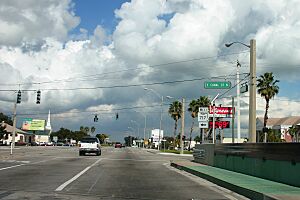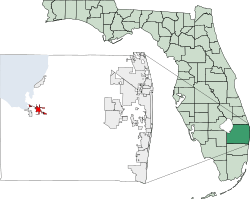Belle Glade, Florida facts for kids
Quick facts for kids
Belle Glade, Florida
|
||
|---|---|---|
| City of Belle Glade | ||

Main Street in Belle Glade
|
||
|
||
| Nickname(s):
Muck City
|
||
| Motto(s):
Her Soil is Her Fortune
|
||

Location of Belle Glade, Florida
|
||
| Country | ||
| State | ||
| County | ||
| Settled (Hillsboro Settlement) | c. 1912–April 8, 1928 | |
| Incorporated (Town of Belle Glade) | April 9, 1928 | |
| Incorporated (City of Belle Glade) | September 11, 1945 | |
| Government | ||
| • Type | Commissioner-Manager | |
| Area | ||
| • Total | 7.03 sq mi (18.21 km2) | |
| • Land | 6.97 sq mi (18.06 km2) | |
| • Water | 0.06 sq mi (0.15 km2) | |
| Elevation | 16 ft (5 m) | |
| Population
(2020)
|
||
| • Total | 16,698 | |
| • Density | 2,395.01/sq mi (924.66/km2) | |
| Time zone | UTC-5 (Eastern (EST)) | |
| • Summer (DST) | UTC-4 (EDT) | |
| ZIP code |
33430
|
|
| Area code(s) | 561, 728 | |
| FIPS code | 12-05200 | |
| GNIS feature ID | 0278445 | |
| Website | http://www.bellegladegov.com/ | |
Belle Glade is a city in south-central Florida. It is located in the western part of Palm Beach County, Florida, right on the southeastern shore of Lake Okeechobee. Belle Glade is part of the Miami metropolitan area in South Florida.
In 2020, the city had a population of 16,698 people. This was a small decrease from the 2010 census. Belle Glade is sometimes called "Muck City." This nickname comes from the rich, dark soil called muck found there. This soil is perfect for growing sugarcane. Even though it's in South Florida, Belle Glade feels more like the Florida Heartland in its culture.
Contents
Discover Belle Glade: History and Location
The Story of Belle Glade
Belle Glade's story is linked to a big project. This project involved draining land around Lake Okeechobee. The goal was to use this land for farming. The town was first built in 1925. However, a powerful hurricane destroyed it three years later. Many people lost their lives in that storm.
After the hurricane, the town was rebuilt. The land around Lake Okeechobee is very fertile. Because of this, farming has always been a key industry here. In the 1960s, many farmworkers from Belle Glade were featured. They appeared in a TV show called Harvest of Shame.
Where is Belle Glade Located?
Belle Glade is found at 26.685264 degrees North and 80.671275 degrees West. The United States Census Bureau says the city covers about 4.7 square miles (12.2 square kilometers). Most of this area is land. Only a tiny part, about 0.21%, is water.
People and Community in Belle Glade
How Many People Live Here?
| Historical population | |||
|---|---|---|---|
| Census | Pop. | %± | |
| 1930 | 926 | — | |
| 1940 | 3,806 | 311.0% | |
| 1950 | 7,219 | 89.7% | |
| 1960 | 11,273 | 56.2% | |
| 1970 | 15,949 | 41.5% | |
| 1980 | 16,535 | 3.7% | |
| 1990 | 16,177 | −2.2% | |
| 2000 | 14,906 | −7.9% | |
| 2010 | 17,467 | 17.2% | |
| 2020 | 16,698 | −4.4% | |
| U.S. Decennial Census | |||
In 2020, Belle Glade had 16,698 residents. There were 6,642 households in the city. About 3,760 families lived there.
A Look at the Community in 2010
In 2010, there were 6,368 households in Belle Glade. About 11.3% of these homes were empty. In 2000, 39.0% of households had children under 18. About 40.9% were married couples. Also, 22.0% had a female head of household with no husband. About 29.3% were not families.
A quarter of all households (23.3%) were single individuals. About 6.1% had someone living alone who was 65 or older. The average household had 3.04 people. The average family had 3.62 people.
Economy and Work in Belle Glade
What Jobs Are There?
The "Sugar Cane Growers Cooperative" (SCGC) has a large cane sugar mill in Belle Glade. This factory employs about 550 people during the harvest season.
In 2013, the official unemployment rate was around 15%. However, the mayor thought the real number was closer to 40%. The number of local jobs decreased. This happened as farming shifted from vegetables to sugarcane. Sugarcane farming uses more machines and fewer workers.
The United States Postal Service runs the Belle Glade Post Office. The Florida Department of Corrections used to operate the Glades Correctional Institution nearby. It closed in December 2011.
Fun and Learning in Belle Glade
Parks and Outdoor Activities
The Lake Okeechobee Scenic Trail goes right through Belle Glade. This trail offers great views and outdoor fun.
Schools and Education
The School District of Palm Beach County manages the public schools in Belle Glade.
Elementary Schools
- Gove Elementary
- Belle Glade Elementary
- Glade View Elementary
- Pioneer Park Elementary
- Sellew Belle Glade Excel Charter School
Middle Schools
- Lake Shore Middle School
High Schools
- Glades Central High School
Private Schools
- Glades Day School
- Lakeside Academy
College Opportunities
- Palm Beach State College has a campus in Belle Glade.
Famous Faces from Belle Glade
Belle Glade is known for its strong football tradition. Together with nearby Pahokee, the area has sent many players to the National Football League.
- Reidel Anthony, former NFL wide receiver
- Brad Banks, CFL quarterback
- Kelvin Benjamin, NFL wide receiver
- Travis Benjamin, NFL wide receiver and punt returner
- Rashaad Duncan, Former NFL Defensive Tackle
- Jessie Hester, former NFL wide receiver
- Santonio Holmes, NFL wide receiver and Super Bowl XLIII MVP
- James Lee, NFL offensive lineman
- Barkevious Mingo, NFL linebacker
- Jimmy Moreland, NFL cornerback
- Louis Oliver, former NFL safety
- Fred Taylor, former NFL running back
- Deonte Thompson, NFL wide receiver
- Andre Waters, former NFL safety
- Rhondy Weston, former NFL defensive lineman
Images for kids
See also
 In Spanish: Belle Glade para niños
In Spanish: Belle Glade para niños






